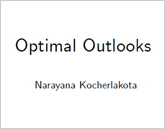Note1
Basic economics says that a policymaker should set a policy instrument so that, on the margin, there is no net benefit to altering it. But while the policymaker’s decision is necessarily made today, the resultant costs and benefits are realized only in the future. Therefore, the policymaker’s optimal choice is to set the policy instrument so that the outlook for the future marginal net benefit is zero. In this talk, I address the following question: How can the policymaker formulate the needed outlook for marginal net benefits? Policymakers often attempt to do so by using statistical models to forecast future marginal net benefits. I argue that policymakers can achieve better outcomes by basing their outlooks on risk-neutral probabilities derived from the prices of financial derivatives.
The benefit of using risk-neutral probabilities arises from the observation that resources may be more valuable in one state of the world relative to another, equally likely, state of the world. (For example, the economy might be in a deep recession in the former state and in a boom in the latter.) In weighing future costs and benefits, the policymaker should take account of this differential valuation of resources in different states. Because they are derived from market prices, risk-neutral probabilities provide the needed information about the relative values of resources in different states of the world in a way that purely statistical forecasts cannot.
After presenting my general argument, I illustrate it using the example of a central bank that has a single mandate of targeting an inflation rate of pi_bar. Monetary policy operates with lags, and inflation is affected by shocks other than the central bank’s decision. Hence, the best that the central bank can do is to ensure that its medium-term outlook for inflation always equals pi_bar. My general argument implies that the appropriate outlook for the central bank is not a statistical forecast of inflation, but rather the risk-neutral expectation of inflation, calculated using risk-neutral probabilities. This risk-neutral expectation can be measured using inflation break-evens on assets like zero coupon inflation swaps or TIPS bonds. Hence, it is optimal for an inflation-targeting central bank to follow policies that ensure that inflation break-evens remain close to pi_bar.
The Federal Reserve Bank of Minneapolis reports measures of risk-neutral probabilities on its website. These reports are based on a variety of option prices and are updated every two weeks.
Endnotes
1 I am speaking for myself today, and not for others in the Federal Reserve or on the Federal Open Market Committee.
Optimal Outlooks
June 3, 2012
President Kocherlakota previously gave a similar speech at the Financial Intermediation Research Society Conference on June 3rd, 2012. View the video of that speech and the Q & A that followed.




